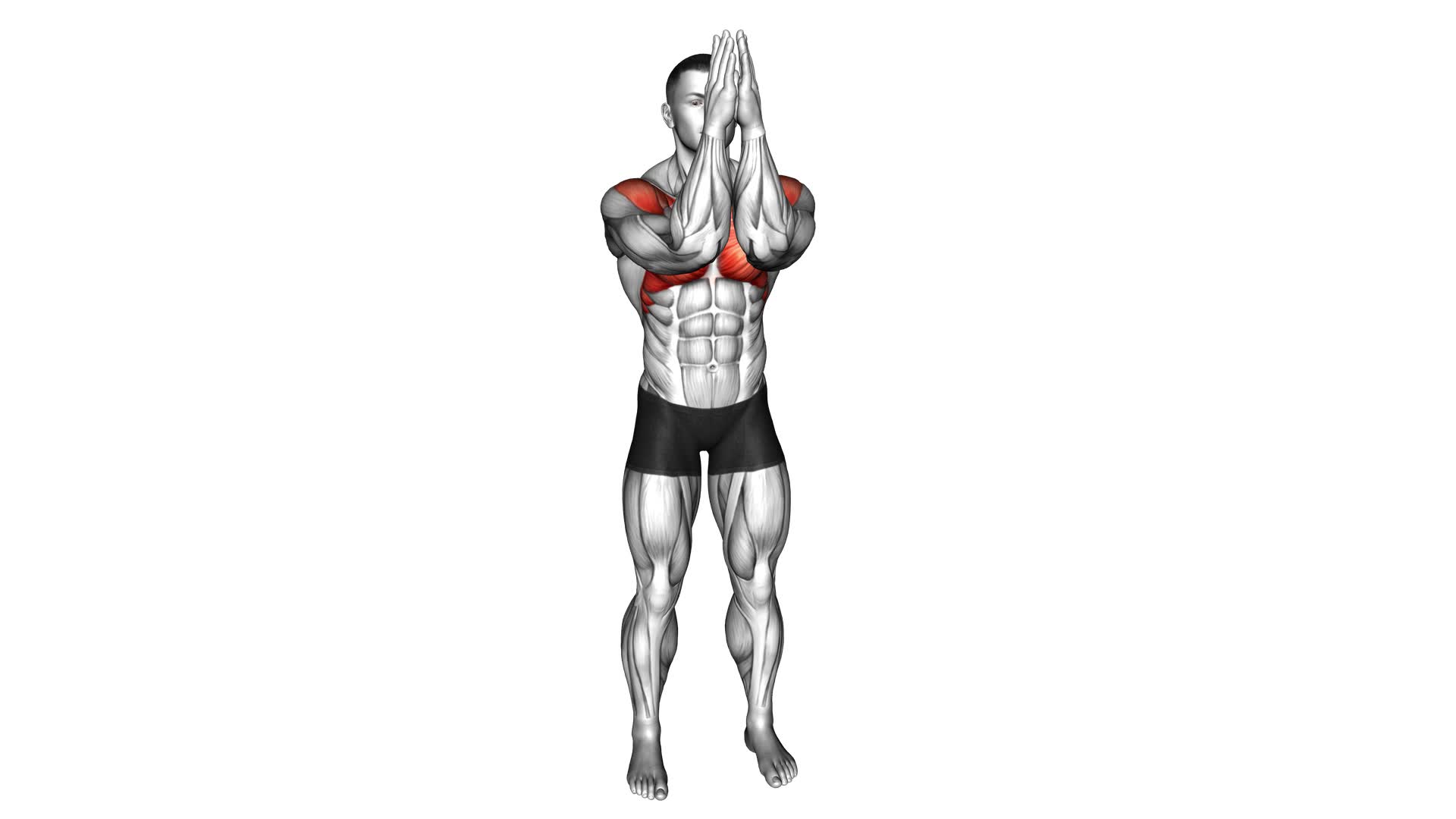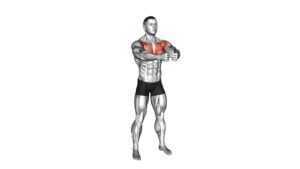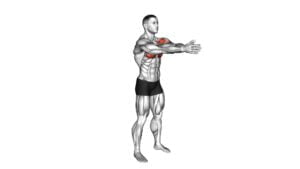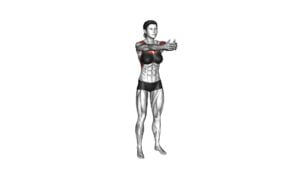Bodyweight Standing Fly (male) – Video Exercise Guide & Tips

If you're looking to strengthen your upper body and improve your posture, the bodyweight standing fly exercise is a must-try.
Watch This Exercise Video
In this video exercise guide, we'll show you the proper form and provide tips to maximize your results.
With no equipment required, you can easily incorporate this exercise into your routine.
Get ready to feel the burn and take your fitness to new heights with the bodyweight standing fly.
Let's get started!
Key Takeaways
- Bodyweight Standing Fly primarily targets the chest muscles, specifically the pectoralis major and pectoralis minor.
- This exercise can be adjusted to target different areas of the chest by varying arm placement.
- Engaging the deltoids (shoulder muscles) and upper back, the Bodyweight Standing Fly improves overall upper body strength and stability.
- Proper form is essential, including maintaining a slight bend at the elbows, avoiding excessive swinging or momentum, and engaging the chest, shoulders, and upper back.
Benefits of Bodyweight Standing Fly
Get stronger and sculpt your chest muscles with the bodyweight standing fly exercise. This exercise has several benefits that can help you achieve your fitness goals.
One of the advantages of the bodyweight standing fly is that it targets the chest muscles specifically, helping you to develop a strong and defined chest. By using your own body weight as resistance, you can effectively work the muscles without the need for additional equipment.
Another benefit of the bodyweight standing fly is that it allows for different variations to keep your workouts interesting and challenging. You can adjust the width of your arm placement to target different areas of the chest. For example, a wider arm placement will engage the outer chest muscles, while a narrower placement will focus more on the inner chest. Additionally, you can vary the tempo and intensity of the exercise to further challenge your muscles and increase strength gains.
However, it's important to be aware of the potential disadvantages of the bodyweight standing fly. As with any exercise, improper form or excessive weight can lead to strain or injury. It's crucial to maintain proper posture, engage your core, and use controlled movements throughout the exercise. Additionally, if you have any pre-existing shoulder or chest injuries, it's advised to consult with a healthcare professional before attempting this exercise.
Proper Form for Bodyweight Standing Fly
To perform the Bodyweight Standing Fly with proper form, you need to pay attention to your arm positioning. Keep your arms extended out to the sides and slightly forward, maintaining a slight bend at the elbows.
This position will ensure that you engage the targeted muscle groups effectively, including your chest, shoulders, and upper back.
Arm Positioning Tips
- Adjust your arm positioning to ensure proper form during the Bodyweight Standing Fly exercise. Proper arm positioning is crucial for targeting the muscles effectively and preventing injury. Here are some tips to help you achieve the correct arm positioning:
- Start by standing with your feet shoulder-width apart and your knees slightly bent.
- Extend your arms straight out to the sides, parallel to the floor.
- Keep a slight bend in your elbows throughout the exercise to avoid strain on the joints.
- Maintain a relaxed but engaged grip on the handles or straps.
- Avoid any excessive swinging or momentum by controlling the movement with your arms and shoulders.
Muscle Groups Targeted
Target the specific muscle groups during the Bodyweight Standing Fly exercise by maintaining proper form and engaging your arms and shoulders. This exercise primarily targets the muscles in your chest, specifically the pectoralis major and pectoralis minor. By performing the Bodyweight Standing Fly, you can effectively strengthen and tone your chest muscles. Additionally, this exercise also engages your deltoids, which are the muscles in your shoulders. Engaging these muscles helps improve your overall upper body strength and stability.
The Bodyweight Standing Fly is a great alternative to traditional weightlifting exercises because it utilizes your own bodyweight as resistance. This means you can perform this exercise anywhere, without the need for equipment. Bodyweight exercises like the Standing Fly have been shown to have numerous benefits, including improved muscular strength, increased flexibility, and enhanced stability. Incorporating bodyweight exercises into your workout routine can provide a well-rounded and effective way to target and strengthen multiple muscle groups.
Essential Equipment for Bodyweight Standing Fly
You will need a mat and a pair of dumbbells for the bodyweight standing fly exercise. Here are the essential equipment you'll need:
- Mat: A mat provides a padded surface for you to perform the exercise comfortably. It also helps to prevent any strain or discomfort on your knees or joints.
- Dumbbells: A pair of dumbbells adds resistance to the exercise, allowing you to effectively target and strengthen your chest muscles. Choose a weight that challenges you but still allows you to maintain proper form.
- Water bottle: Staying hydrated is important during any workout. Keep a water bottle nearby to ensure you can replenish your fluids as needed.
- Towel: Sweating is a natural part of exercising, so having a towel nearby will help you stay dry and comfortable throughout your workout.
- Timer or stopwatch: Keeping track of your rest periods and tracking your progress is essential. A timer or stopwatch will help you stay on track and ensure you're getting the most out of your workout.
The bodyweight standing fly exercise offers several benefits, such as strengthening your chest muscles, improving upper body stability, and enhancing overall body control.
If you're looking for alternative exercises to the bodyweight standing fly, you can try push-ups, chest presses, or resistance band chest flies. These exercises also target the chest muscles and provide similar benefits.
Common Mistakes to Avoid During Bodyweight Standing Fly
To avoid common mistakes during the bodyweight standing fly exercise, make sure to maintain proper form and engage your chest muscles throughout the movement. Proper form is essential for maximizing the effectiveness of this exercise and preventing injury.
One common mistake to avoid is rounding your shoulders forward. This can put unnecessary strain on your neck and upper back. Instead, focus on keeping your shoulders back and down, with your chest lifted.
Another mistake to watch out for is relying solely on your arms to perform the movement. Remember, the primary muscles targeted in the bodyweight standing fly are the chest muscles. To engage them properly, imagine squeezing your chest together as you bring your arms forward. This will help activate the chest muscles and ensure they're doing the majority of the work.
Additionally, a common misconception about the bodyweight standing fly is that it's solely an exercise for the pectoral muscles. While it does primarily target the chest, it also engages the shoulders and arms, making it a great compound exercise for the upper body.
Advanced Variations of Bodyweight Standing Fly
Try incorporating resistance bands or dumbbells for an added challenge in the advanced variations of the Bodyweight Standing Fly exercise. Here are some advanced progressions, variations, and modifications to take your workout to the next level:
- Single Leg Fly: Stand on one leg while performing the Standing Fly exercise. This variation helps improve balance and stability while targeting the chest muscles.
- Incline Fly: Set up an incline bench at a 45-degree angle and perform the Standing Fly exercise. This variation increases the range of motion and targets the upper chest muscles.
- Decline Fly: Set up a decline bench at a 45-degree angle and perform the Standing Fly exercise. This variation places more emphasis on the lower chest muscles.
- Resistance Band Fly: Attach resistance bands to an anchor point and hold them with your hands while performing the Standing Fly exercise. The resistance bands provide constant tension throughout the movement, increasing the challenge.
- Dumbbell Fly: Hold a dumbbell in each hand while performing the Standing Fly exercise. The added weight increases the intensity and strengthens the chest muscles.
Remember these bodyweight fly technique tips for optimal results: keep your core engaged, maintain proper form throughout the movement, and control the pace of the exercise.
Incorporating these advanced variations will help you continue to challenge your muscles and make progress in your fitness journey.
Tips for Progressing and Increasing Intensity in Bodyweight Standing Fly
To increase the intensity and progress in your Bodyweight Standing Fly exercise, incorporate the following tips.
One way to modify the bodyweight standing fly is by using resistance bands. Attach the bands to a sturdy anchor point and hold the handles in each hand. This adds resistance to your fly movement, making it more challenging.
Another modification is to increase the range of motion by standing on an elevated surface, such as a step or platform. This allows your arms to extend further back, engaging more muscles in your back and shoulders.
Common challenges in bodyweight standing fly progression include not being able to maintain proper form and difficulty in increasing the resistance. To address these challenges, focus on maintaining a strong core and keeping your shoulders down and back throughout the movement. This will help prevent any excessive strain on your lower back.
To increase the resistance, you can gradually add weight by using dumbbells or weighted vests. Start with a weight that challenges you but still allows you to maintain proper form. As you get stronger, gradually increase the weight to continue progressing in your bodyweight standing fly exercise.
Remember to listen to your body and progress at a pace that feels comfortable and safe for you.
Frequently Asked Questions
How Many Calories Does the Bodyweight Standing Fly Exercise Burn?
The bodyweight standing fly exercise can be an effective way to burn calories and aid in weight loss. By engaging multiple muscles in your upper body, such as your chest, shoulders, and arms, this exercise can help boost your metabolism and increase calorie burn.
Incorporating the bodyweight standing fly into your workout routine can be a great addition to your weight loss goals.
Can the Bodyweight Standing Fly Exercise Help With Weight Loss?
The bodyweight standing fly exercise can definitely help with weight loss. By incorporating different variations of the bodyweight standing fly into your workout routine, you can target multiple muscle groups and increase calorie burn.
Bodyweight exercises are great for weight loss because they require no equipment and can be done anywhere. They also help build strength and improve overall fitness.
What Muscles Does the Bodyweight Standing Fly Target?
The bodyweight standing fly is a great exercise that targets multiple muscles in your upper body. It's an effective way to build strength and muscle tone.
To get the most out of this exercise, it's important to maintain proper form. Keep your core engaged and your back straight. Focus on squeezing your chest muscles as you bring your arms together.
Incorporating this exercise into your weightlifting routine can have many benefits for your overall fitness.
Is the Bodyweight Standing Fly Exercise Suitable for Beginners?
Proper form is crucial for the bodyweight standing fly exercise.
Beginners can modify this exercise to make it more suitable for their fitness level.
It's important to start with lighter weights or no weights at all, and focus on mastering the correct technique before progressing.
By gradually increasing the resistance and intensity, you can build strength and avoid injuries.
Remember to consult with a professional trainer for personalized guidance and to ensure you're performing the exercise correctly.
How Often Should the Bodyweight Standing Fly Exercise Be Performed for Optimal Results?
For optimal results, it's important to perform the bodyweight standing fly exercise regularly. To ensure proper form and technique, focus on keeping your core engaged and maintaining a controlled movement throughout the exercise.
As for frequency, aim to incorporate the bodyweight standing fly exercise into your workout routine 2-3 times per week. Remember, it's always a good idea to consult with a fitness professional to determine the best frequency for your individual fitness goals and abilities.
Conclusion
In conclusion, the bodyweight standing fly is a highly effective exercise for targeting the muscles in the chest and shoulders. By using only your bodyweight, you can strengthen and tone these muscles without the need for any equipment.
It's important to maintain proper form and avoid common mistakes to maximize the benefits of this exercise. As you progress, you can also try advanced variations and increase intensity to continue challenging your muscles.
Incorporate the bodyweight standing fly into your workout routine for a stronger upper body.

Author
Years ago, the spark of my life’s passion ignited in my mind the moment I stepped into the local gym for the first time. The inaugural bead of perspiration, the initial endeavor, the very first surge of endorphins, and a sense of pride that washed over me post-workout marked the beginning of my deep-seated interest in strength sports, fitness, and sports nutrition. This very curiosity blossomed rapidly into a profound fascination, propelling me to earn a Master’s degree in Physical Education from the Academy of Physical Education in Krakow, followed by a Sports Manager diploma from the Jagiellonian University. My journey of growth led me to gain more specialized qualifications, such as being a certified personal trainer with a focus on sports dietetics, a lifeguard, and an instructor for wellness and corrective gymnastics. Theoretical knowledge paired seamlessly with practical experience, reinforcing my belief that the transformation of individuals under my guidance was also a reflection of my personal growth. This belief holds true even today. Each day, I strive to push the boundaries and explore new realms. These realms gently elevate me to greater heights. The unique combination of passion for my field and the continuous quest for growth fuels my drive to break new ground.







